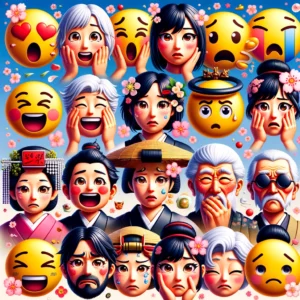Emojis from different cultures can have distinct meanings and connotations. Japanese emoji faces in particular have some unique symbols and implications rooted in Japanese culture.
This comprehensive guide will explore the most popular Japanese emoji faces, explain what they communicate, and provide tips for using them appropriately.
What are Japanese Emoji Faces?
Japanese emoji faces refer to the emoji faces originating from Japanese culture. Many of these express emotions and concepts significant in Japanese society. For example, Japan contributed emojis like 😅 smiling face with sweat and 💢 anger symbol that reflect common manga/anime tropes.
While emoji faces are universally understood at a basic level, the Japanese versions offer some culturally nuanced designs. Their art styles and connections to Japanese media give them a distinct look and meaning.
Meanings of Popular Japanese Emoji Faces
Here are some of the most common Japanese emoji faces and their culturally relevant meanings:
😅 Smiling Face With Sweat
In Japanese culture, sweating signifies embarrassment or exasperation. This emoji conveys a smiling outward appearance masking panicked frustration inside. It feigns confidence but actually feels awkward.
😮💨 Face Exhaling
Exhaling conveys relief after a close call or tense situation. This emoji is used when feeling exhausted but glad a problem resolved. It communicates the feeling “phew, that was a close one!”.
😱 Face Screaming in Fear
Screaming or reacting with exaggerated shock is popular in “kawaii” (cute) Japanese media. This emoji expresses shock, fear, or feeling intensely startled.
😖 Confounded Face
This emoji is unique to Japan. It shows frustration while also blushing. The sideways mouth and furrowed brows convey being confounded and dismayed.
😤 Face With Steam From Nose
In manga/anime, steam from the nose signifies intense anger. This emoji perfectly encapsulates the Japanese symbolism of rage being pent-up and about to burst.
💢 Anger Symbol
This abstract red symbol uniquely signifies anger in Japanese pop culture. It’s often combined with other emojis to emphasize frustration.
💦 Sweat Droplets
Japan contributed the sweat droplets emoji, which conveys nervousness, awkward tension, or exasperation. It fits with the cultural theme of sweat symbolizing unease.
When to Use Japanese Emoji Faces
Japanese emoji faces add visual pop to express reactions commonly conveyed in Japanese pop culture. Some appropriate situations include:
Overreacting to Stress
When overwhelmed, use emojis like 😱 face screaming in fear or 😖 confounded face to emphasize your chaotic reaction in a funny way.
Awkward Social Situations
If you feel uncomfortable or anxious during a conversation, add 😅 smiling face with sweat to humorously convey hidden awkwardness behind a polite smile.
Intense Exasperation
Emojis like 😤 face with steam from nose and 💢 anger symbol amplify irritation or rage, especially in response to frustrating situations.
Playful Teasing
Poking fun at friends using exaggerated emoji reactions like 😱 face screaming in fear shows lighthearted camaraderie.
Relieving Stress
Sending relieved emojis like 😮💨 face exhaling conveys taking a breather after tense or tiring situations.
Examples of Using Japanese Emoji Faces
Here are some examples of appropriately using these emojis in conversations:
“I still have 3 more hours of work left 😅”
“Omg I can’t believe I slept through my alarm! 😱”
“Phew, finally submitted my project 😮💨”
“John’s terrible dad jokes are so cringey 💢😤”
“Having dinner with my boss tonight…hope it’s not awkward 😖😅”
Key Tips for Using Japanese Emoji Faces
- Use them sparingly within a message for clearer communication. Too many can seem overkill.
- Add some text to provide context for which emotions the faces are meant to convey.
- Mirror the tone of the conversation – inject them into lighthearted messages rather than serious talks.
- Consider your audience and avoid Japanese emoji faces in professional settings where misinterpretation is possible.
- Remember that faces like 😅 smiling with sweat have slightly different implications across cultures.
When to Exercise Caution with Japanese Emoji Faces
Because Japanese emoji faces portray exaggerated emotions, take care when:
- Communicating with someone who may not grasp the cultural context.
- Discussing solemn news or delicate emotional matters requiring nuance.
- Dealing with angry or confrontational people, as more intense faces could further provoke them.
- Someone prefers more direct and open communication vs conveying feelings through embellished emoji.
Key Takeaways – Japanese Emoji Faces
- Japanese emoji faces like 😅 smiling face with sweat have distinct meanings rooted in Japanese culture and media.
- Faces with sweat or steam coming out of them convey exasperation, awkwardness, or embarrassment.
- Exaggerated emojis like 😱 face screaming in fear and 💢 anger symbol match Japanese media’s dramatic portrayals of emotions.
- Use Japanese emoji faces to humorously emphasize reactions to stress, awkwardness, frustration and other situations.
- Consider your audience and relationship, as those unfamiliar with the cultural context may misinterpret exaggerated emoji.
With an appreciation for their origins, Japanese emoji faces can enhance your conversational repertoire. Just be thoughtful about conveying emotion across cultures. A facial emoji like 😊 can connect us all!
